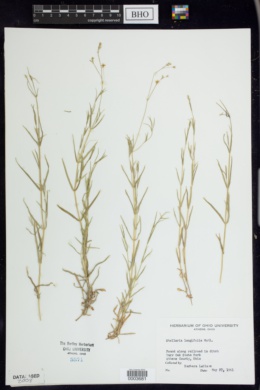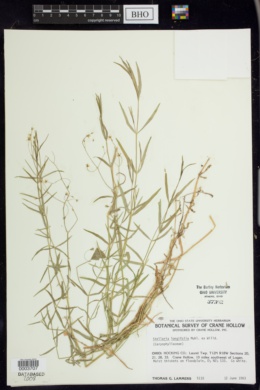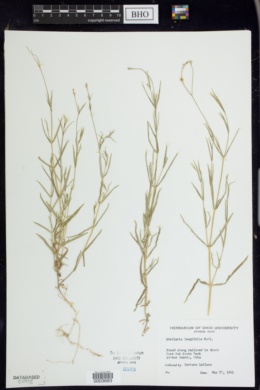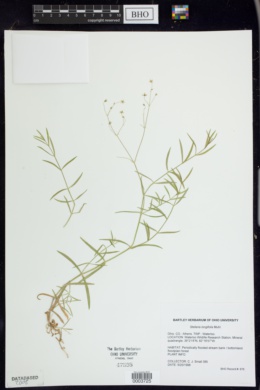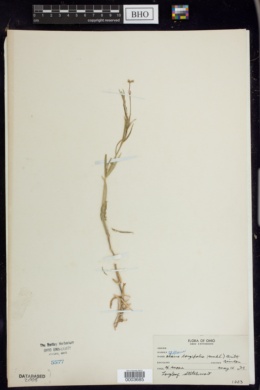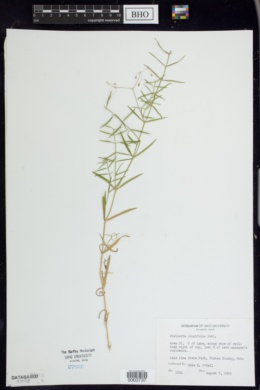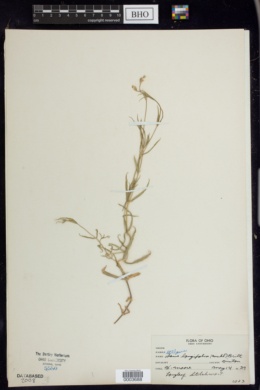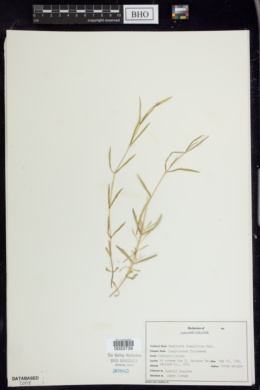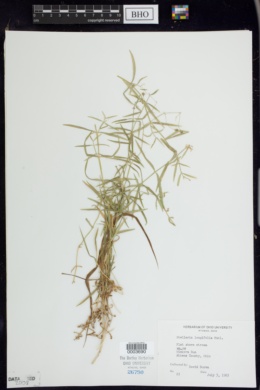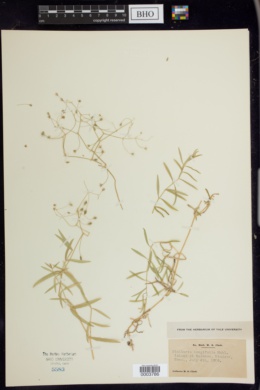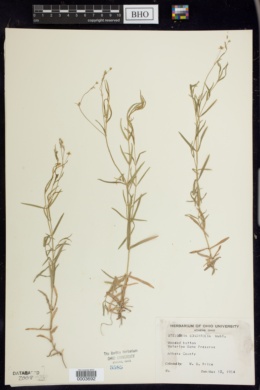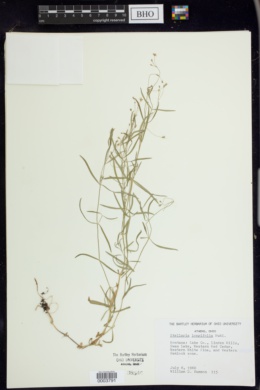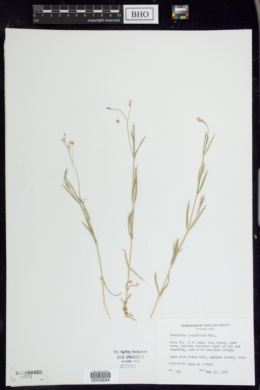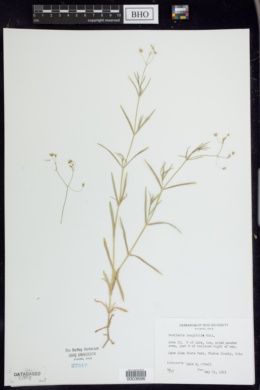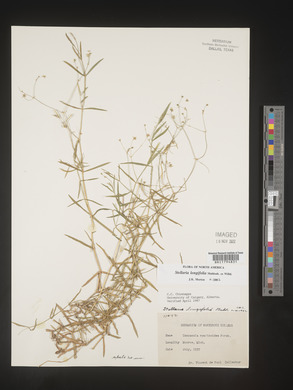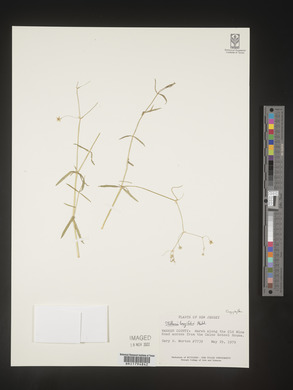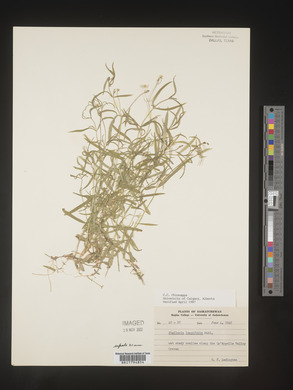Stellaria longifolia
|
|
|
|
Family: Caryophyllaceae
Long-Leaf Starwort, more...longleaf starwort, longleaf chickweed
[Stellaria atrata var. eciliata, moreStellaria friesiana Ser., Stellaria longifolia var. eciliata (B. Boivin) B. Boivin, Stellaria longifolia var. subaequalis J. W. Moore] |
Plants perennial, forming loose clumps, from elongate rhizomes. Stems erect or straggling, branched, square, 10-35 cm, glabrous but angles minutely papillate-scabrid. Leaves sessile; blade green to yellowish green, never glaucous, linear to very narrowly elliptic, widest at or beyond middle, 0.8-4 cm × 1-3 mm, not coriaceous, base attenuate, apex acuminate to acute, glabrous to sparingly ciliate at base, margins minutely papillate-scabrid; proximal leaves shorter and wider. Inflorescences terminal, widely divaricate, 2-many-flowered cymes; bracts lanceolate, 1-5 mm, scarious, apex acuminate. Pedicels straight or somewhat arcuate, commonly 3-30 mm, glabrous or scabrous. Flowers 5-9 mm diam.; sepals 5, obscurely 3-veined, ovate-elliptic, 2-4 mm, margins scarious, apex acute, glabrous; petals 5, 2-3.5 mm, ± equaling sepals; stamens 5-10; styles 3, ascending, ca. 1 mm. Capsules blackish purple or straw colored, ovoid-conic, 3-6 mm, much longer than sepals, opening by 6 valves; carpophore absent. Seeds brown, broadly reniform, 0.7-0.8 mm diam., slightly rugose. 2n = 26. Flowering late spring-summer. Wet meadows and woodlands, marshes, muskegs, grassy roadsides, usually in circumneutral to calcareous sites; 0-2800 m; St. Pierre and Miquelon; Alta., B.C., Man., N.B., Nfld. and Labr., N.W.T., N.S., Ont., Que., Sask., Yukon; Alaska, Ariz., Calif., Colo., Conn., Del., D.C., Idaho, Ill., Ind., Iowa, Ky., Maine, Md., Mass., Mich., Minn., Mo., Mont., Nebr., Nev., N.H., N.J., N.Y., N.Dak., Ohio, Pa., R.I., S.C., S.Dak., Tenn., Vt., Va., Wash., W.Va., Wis., Wyo.; Europe. Stellaria longifolia often is confused with forms of S. longipes but differs in having leaves that are widest at or above the middle and in having the angles of the stem and/or the leaf margins minutely papillate-scabrid. The capsules can be either straw colored or black. Plants with black capsules have been named var. atrata. Hybrids with Stellaria borealis subsp. borealis often occur; see note under that species.
Perennial herb with elongate rhizomes 10 - 45 cm tall Stem: straggling or upright, clump-forming, branched, four-angled, weak, sometimes rough along the angles. Leaves: opposite, stalkless, yellowish green to green, 0.8 - 5 cm long, 1 - 6 mm wide, lower leaves shorter and wider than upper ones, linear to narrowly elliptic with a narrowing base and pointed tip, widest at or near the middle, minutely bumpy along the margins, one-veined, and sometimes sparsely fringed with hairs (at the base of the leaf). Inflorescence: a terminal, widely branched cluster (cyme) of two to many flowers, rarely over 10 cm long, subtended by a pair of bracts. Bracts 1 - 5 mm long, lance-shaped, and scarious-margined (dry, thin, and membranous). Flowers: white, 5 - 9 mm wide. Stalk straight or somewhat curved, spreading or reflexed, slender, to 3 cm long. Stamens five to ten. Styles three. Sepals: five, distinct, green, 2 - 4.5 mm long, lance-shaped to egg-shaped to elliptic with a pointed tip, weakly three-veined, scarious-margined (dry, thin, and membranous). Petals: five, white, 2 - 3.5 mm long, more or less equal to or longer than the sepals, deeply two-lobed (giving the appearance of ten petals). Fruit: a dehiscent capsule, opening by six valves, straw-colored or blackish purple, 3 - 6 mm long, longer than sepals, egg-shaped to conic. Seeds brown, under 1 mm long, broadly kidney-shaped, laterally compressed, slightly wrinkled, virtually smooth. Similar species: The similar Stellaria crassifolia differs by having completely hairless leaves, solitary flowers that grow in the forks of stems, and bracts without scarious margins. Stellaria graminea is also similar but has strongly veined sepals and seeds wrinkled in concentric rings. Flowering: mid-May to mid-July Habitat and ecology: Local in moist shrub-carr communities. Also found in decayed bogs and other moist places such as floodplains. Occurence in the Chicago region: native Etymology: Stellaria comes from the Latin words stella, meaning star, and -aria meaning "pertaining to," referring to the shape of the flowers. Longifolia means "long-leaved." Author: The Morton Arboretum Perennial; stems weak. 1.5-4.5 dm, glabrous or sometimes scabrous on the 4 prominent angles; lvs linear or lanceolate to narrowly elliptic or oblanceolate, 2-5 cm נ2-6 mm, sometimes ciliate at base; infl terminal or pseudolateral, seldom over 10 cm, divaricately branched, few-fld; bracts scarious, sometimes ciliolate; pedicels slender, spreading or reflexed; sep lanceolate or lance-ovate, acute, weakly 3-nerved, scarious-margined, seldom ciliolate, 3.5-4.5 mm in fr; pet exceeding the sep; fr somewhat or much surpassing the sep, stramineous or dark, short- to elongate-conic; seeds oblong, 0.7-1 mm; obscurely sculptured, virtually smooth; 2n=26. Moist, grassy places and damp woods; circumboreal, s. in Amer. at least to Va., Mo., Kans., Ariz., and Calif. (Alsine l.) Hybridizes with no. 10 [Stellaria borealis Bigelow]. Gleason, Henry A. & Cronquist, Arthur J. 1991. Manual of vascular plants of northeastern United States and adjacent Canada. lxxv + 910 pp. ©The New York Botanical Garden. All rights reserved. Used by permission. From Flora of Indiana (1940) by Charles C. Deam Infrequent to rare throughout the state in low or moist woodland and marshes, on the low borders of lakes, and rarely in the open along ditches. …… Indiana Coefficient of Conservatism: C = 7 Wetland Indicator Status: FACW |






